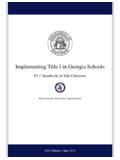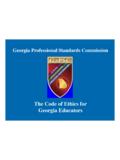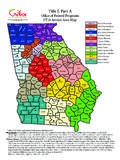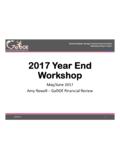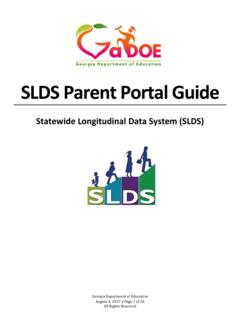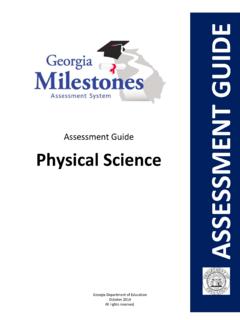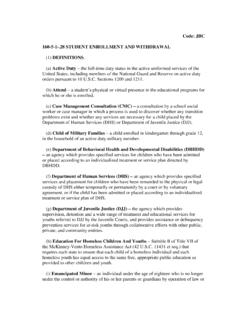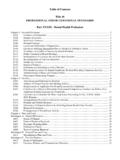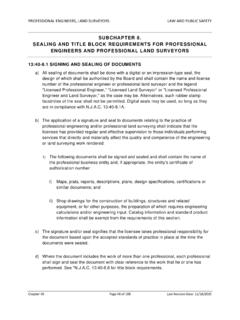Transcription of Implementing Title I in Georgia Schools - gadoe.org
1 Implementing Title I in Georgia Schools Handbook for Title I Directors Richard Woods, State School Superintendent February 2018 Implementing Title I in Georgia Schools FY18 Handbook for Title I Directors Georgia Department of Education February 2018 Page 2 The contents of this handbook were developed under a grant from the Department of Education. However, those contents do not necessarily represent the policy of the Department of Education, and you should not assume endorsement by the federal government. For additional information regarding this handbook, contact: Georgia Department of Education Federal Programs Division 1858 Twin Towers East Atlanta, Georgia 30334 Implementing Title I in Georgia Schools FY18 Handbook for Title I Directors Georgia Department of Education February 2018 Page 3 Table of Contents LEA Identification and Selection of School Attendance Areas and Schools , and Allocations of Title I Funds to School Attendance Areas and Schools (Sec.)
2 1113) .. 5 General Selection 5 LEA Discretion in Selecting Participating Areas and Schools .. 6 Allocating Title I Funds to Participating Areas and Schools .. 7 Opening New Schools : Gathering Needed Data Enrollment and Free and Reduced Numbers .. 9 Allocating Title I Funds to Redistricted Schools .. 9 Directions for Calculating Eligible Attendance Areas .. 10 Healthy, Hunger-Free Kids Act of 2010 (Act) .. 13 Background .. 13 Guidance for Meeting Title I Requirements .. 14 Charter Schools and Title I, Part A .. 18 Allocation of Federal Formula Funds to Charter Schools Within State Allocations .. 20 Federal Formula Allocation During First Year and for Successive Enrollment Expansions.
3 21 Comparability of Services .. 23 Introduction .. 23 Requirement .. 24 Criteria for Meeting 24 Developing Procedures for 25 Compliance Timeline .. 26 Instructional Staff Members to be Included .. 26 Grouping of Schools for Comparability Comparison .. 27 LEA Organization .. 27 Grouping by Size of Enrollment .. 28 Grouping When All Schools Receive 29 Examples of Ways to Meet the Comparability Requirement .. 30 Meeting Comparability through the Resource Allocation Process .. 37 Schoolwide Programs Definition and Details .. 38 Using Title I Schoolwide Programs to Support School Reform .. 38 Benefiting from Operating a Schoolwide Program .. 39 Implementing a Schoolwide Program .. 39 Safeguarding the Interests of Historically Underserved Populations.
4 40 Using Federal Funds Flexibly in a Schoolwide Program .. 42 Implementing Title I in Georgia Schools FY18 Handbook for Title I Directors Georgia Department of Education February 2018 Page 4 Examples of Uses of Funds in a Schoolwide Program (Based on the Needs Assessment)42 Existing Guidance on Schoolwide Programs .. 42 Schoolwide Programs (SWP) Tools and Resources .. 43 Targeted-Assistance Title Programs .. 44 Targeted-Assistance Programs Definition and Description .. 44 Components of a Targeted-Assistance School Program .. 46 Requirements .. 48 Simultaneous Service .. 48 Comprehensive Services .. 48 Professional Development .. 49 Existing Targeted-Assistance Programs .. 49 Title I Committee of Practitioners (COP).
5 50 Title I Committee of Practitioners Guidelines .. 50 Membership .. 50 Duties .. 51 Term Limits .. 51 Meeting Schedule .. 51 Member 52 Selection Process .. 52 Intradistrict Transfer Option .. 52 Paraprofessionals .. 53 Professional Qualification Requirements for Paraprofessionals in CHARTER Schools that DO NOT Require Certification: .. 53 Parent and Family Engagement .. 54 Notices to Parents of English Learners (ELs) .. 54 Academic Achievement Awards Program .. 56 Title I Reward Schools Program .. 56 Introduction .. 56 Timelines .. 57 How State Data Will Be Run to Determine List of Highest-Performing Title I Reward Schools .. 57 How State Data Will Be Run to Determine List of High-Progress Title I Reward Schools57 How State Will Recognize and Reward the Title I Highest-Performing and High-Progress Schools .
6 58 Implementing Title I in Georgia Schools FY18 Handbook for Title I Directors Georgia Department of Education February 2018 Page 5 Purpose of Title I, Part A The purpose of Title I, Part A is to provide all children significant opportunity to receive a fair, equitable, and high-quality education, and to close educational achievement gaps (Sec. 1001) LEA Identification and Selection of School Attendance Areas and Schools , and Allocations of Title I Funds to School Attendance Areas and Schools (Sec. 1113) A local educational agency (LEA) will use funds received under Title I, Part A only in eligible school attendance areas. The term school attendance area means, in relation to a particular school, the geographical area in which the children who are normally served by that school reside.
7 For Georgia , this includes any public, charter, or virtual school within the LEA s attendance area. The term eligible school attendance area means a school attendance area in which the percentage of children from low-income families is at least as high as the percentage of children from low-income families served by the LEA as a whole. The following points summarize the requirements of Section 1113 of ESEA and , and of the Title I regulations for identifying eligible school attendance areas; selecting those eligible areas that will participate in Title I, Part A; and allocating Title I, Part A funds to participating areas. General Selection Requirements An LEA must annually rank all of its school attendance areas (the geographic area from which a public school draws its children) according to their percentages of poverty.
8 An LEA must use the same measure of poverty for: o Identifying eligible school attendance areas. o Determining the ranking of each area. o Determining the allocation for each area. The LEA must select a poverty measure from the following options: o Children ages 5 to 17 in poverty as counted in the most recent census data approved by the secretary. o Children eligible for free or reduced meals (FRM) under the Richard B. Russell National School Lunch Act. o Children in families receiving assistance under the state program funded under Title IV of the Social Security Act Temporary Assistance for Needy Families (TANF). Implementing Title I in Georgia Schools FY18 Handbook for Title I Directors Georgia Department of Education February 2018 Page 6 o Children eligible to receive medical assistance under the Medicaid program.
9 O A composite of any of the above measures. Identified students under Community Eligibility Provision (CEP) are eligible under the Richard B. Russell NSLP. If an LEA selects NSLP data as its poverty measure (or uses the data in a composite) and has a CEP school, the CEP data will be part of the NSLP data that the LEA uses for within district allocation. An LEA must rank school attendance areas based on the percentage (not the number) of low-income children counted. After an LEA has ranked all of its school attendance areas by poverty, the LEA must first serve, in rank order of poverty, its areas above 75-percent poverty, including any middle Schools or high Schools . EXCEPTION An LEA may choose to lower the 75-percent poverty threshold to 50-percent for high Schools .
10 Only after an LEA has served all of its areas with a poverty rate above 75-percent may the LEA serve lower-ranked areas. The LEA has the option to (1) continue on with the districtwide ranking or (2) rank remaining areas by grade-span groupings. If an LEA has no school attendance areas above 75-percent poverty, the LEA may rank its Schools districtwide or by grade-span groupings. An LEA s organization of its Schools defines its grade-span groupings. For example, if an LEA has elementary Schools serving all elementary grades, middle Schools , and high Schools , the grade-span groupings would be grades K to 5, 6 to 8, and 9 to 12. To the extent that an LEA has Schools that overlap grade spans ( , K to 5, K to 8, 6 to 12), the LEA should include a school in the grade span in which there are the greatest number of grades represented.
